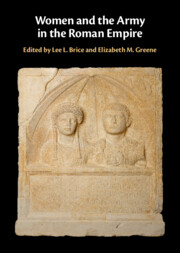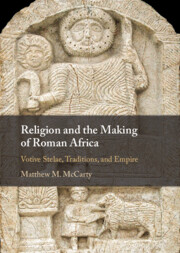Refine search
Actions for selected content:
23916 results in Ancient history
4 - Making a God
- from Part II - Themes in the Making of Hegemony
-
- Book:
- Religion and the Making of Roman Africa
- Published online:
- 24 October 2024
- Print publication:
- 07 November 2024, pp 115-175
-
- Chapter
- Export citation
Index
-
- Book:
- Women and the Army in the Roman Empire
- Published online:
- 24 October 2024
- Print publication:
- 07 November 2024, pp 327-332
-
- Chapter
- Export citation
10 - Mater Castrorum
-
-
- Book:
- Women and the Army in the Roman Empire
- Published online:
- 24 October 2024
- Print publication:
- 07 November 2024, pp 270-298
-
- Chapter
- Export citation
8 - Remaking Spaces and Societies
- from Part II - Themes in the Making of Hegemony
-
- Book:
- Religion and the Making of Roman Africa
- Published online:
- 24 October 2024
- Print publication:
- 07 November 2024, pp 320-383
-
- Chapter
- Export citation
Abbreviations
-
- Book:
- Women and the Army in the Roman Empire
- Published online:
- 24 October 2024
- Print publication:
- 07 November 2024, pp xvii-xvii
-
- Chapter
- Export citation
Abbreviations
-
- Book:
- Religion and the Making of Roman Africa
- Published online:
- 24 October 2024
- Print publication:
- 07 November 2024, pp xviii-xx
-
- Chapter
- Export citation
Appendix 1 - Appendices
- from 7 - (In)Visible Women and Children
-
- Book:
- Women and the Army in the Roman Empire
- Published online:
- 24 October 2024
- Print publication:
- 07 November 2024, pp 215-215
-
- Chapter
- Export citation
Contents
-
- Book:
- Women and the Army in the Roman Empire
- Published online:
- 24 October 2024
- Print publication:
- 07 November 2024, pp vii-viii
-
- Chapter
- Export citation
References
-
- Book:
- Religion and the Making of Roman Africa
- Published online:
- 24 October 2024
- Print publication:
- 07 November 2024, pp 398-446
-
- Chapter
- Export citation
Figures
-
- Book:
- Religion and the Making of Roman Africa
- Published online:
- 24 October 2024
- Print publication:
- 07 November 2024, pp viii-xiv
-
- Chapter
- Export citation
Copyright page
-
- Book:
- Religion and the Making of Roman Africa
- Published online:
- 24 October 2024
- Print publication:
- 07 November 2024, pp iv-iv
-
- Chapter
- Export citation
1 - Colonial Traditions
- from Part I - Colonial Histories
-
- Book:
- Religion and the Making of Roman Africa
- Published online:
- 24 October 2024
- Print publication:
- 07 November 2024, pp 3-26
-
- Chapter
-
- You have access
- HTML
- Export citation
Part I - Colonial Histories
-
- Book:
- Religion and the Making of Roman Africa
- Published online:
- 24 October 2024
- Print publication:
- 07 November 2024, pp 1-80
-
- Chapter
- Export citation
4 - Elite Marriage and Adultery in the Camp
-
-
- Book:
- Women and the Army in the Roman Empire
- Published online:
- 24 October 2024
- Print publication:
- 07 November 2024, pp 84-109
-
- Chapter
- Export citation
7 - Making Offerings
- from Part II - Themes in the Making of Hegemony
-
- Book:
- Religion and the Making of Roman Africa
- Published online:
- 24 October 2024
- Print publication:
- 07 November 2024, pp 270-319
-
- Chapter
- Export citation
Appendix 2 - Concordance of Ancient/Modern Place Names
-
- Book:
- Religion and the Making of Roman Africa
- Published online:
- 24 October 2024
- Print publication:
- 07 November 2024, pp 394-397
-
- Chapter
- Export citation

Women and the Army in the Roman Empire
-
- Published online:
- 24 October 2024
- Print publication:
- 07 November 2024

Religion and the Making of Roman Africa
- Votive Stelae, Traditions, and Empire
-
- Published online:
- 24 October 2024
- Print publication:
- 07 November 2024
Chapter 1 - The Discourse on Romanization in the Age of Empires
-
- Book:
- Decolonizing Roman Imperialism
- Published online:
- 03 October 2024
- Print publication:
- 17 October 2024, pp 15-50
-
- Chapter
- Export citation
References
-
- Book:
- Decolonizing Roman Imperialism
- Published online:
- 03 October 2024
- Print publication:
- 17 October 2024, pp 206-224
-
- Chapter
- Export citation
